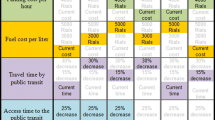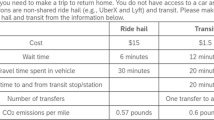Abstract
The paper presents an application of the choice-based sample to explain the choice of non-chosen alternatives. It uses a passenger survey of GO rail transit of the Greater Toronto and Hamilton Area to investigate the factors that may affect the potential mode switching of the current GO rail users. It used a hybrid generalized extreme value with an endogenous latent variables model for jointly modelling the GO rail station access mode choice and the choice of switching from GO rail to alternative modes. The empirical results reveal that the influence of station access difficulty does not become an issue for relatively shorter access distance (e.g. station access distance is less than 5% of the total origin–destination distance). The traveller would rather switch access mode than switching away from GO rail for such a case. Competition of alternative modes, captured through the composite cost of using an alternative to GO rail, is also found to be critical in potential switching from GO rail. It is also clear that drive-alone is the most attractive alternative to switch to. Overall, the empirical investigations reveal that land-use policies that encourage higher residential density around a GO rail station would make a higher number of modes (including non-motorized modes) feasible as access to GO rail mode and thereby reduce the impact of access cost on mode switching behaviour from GO rail. Similarly, developing a high occupancy vehicle lane network and high occupancy tolled road network to serve along the corridors that are served by GO rail would encourage multimodality and help to tackle GO rail’s capacity constraints and their corresponding negative effect of in-train crowding.




Similar content being viewed by others
References
Aptech (2016) GAUSS. www.aptech.com. Accessed 1 July 2018
Asensio J (2002) Transport mode choice by commuters to Barcelona’s CBD. Urban Stud 39(10):1881–1895
Ben-Akiva M, Lerman SR (1985) Discrete choice analysis: theory and application to travel demand. The MIT Press
Bhat CR (1997) Work travel mode choice and number of non-work commute stops. Transp Res Part B Methodol 31(1):41–54
Bhat CR (2001) Quasi-random maximum simulated likelihood estimation of the mixed multinomial logit model. Transp Res Part B Methodol 35(7):677–693
Cantwell M, Caulfield B, Mahony MO (2009) Examining the factors that impact public transport commuting satisfaction. J Public Transp 12(2):1–21
Chakour V, Eluru N (2014) Analyzing commuter train user behavior: a decision framework for access mode and station choice. Transportation 41(1):211–228
Chum GL, Burris MW (2008) Potential mode shift from transit to single-occupancy vehicles on a high-occupancy toll lane. Transp Res Rec J Transp Res Board 2072(2072):10–19
Daly A, Bierlaire M (2006) A general and operational representation of generalised extreme value models. Transp Res Part B Methodol 40(4):285–305
Daly A, Hess S, Patruni B, Potoglou D, Rohr C (2012) Using ordered attitudinal indicators in a latent variable choice model: a study of the impact of security on rail travel behaviour. Transportation 39(2):267–297
Eboli L, Mazzulla G (2007) Service quality attributes affecting customer satisfaction for bus transit. J Public Transp 10(3):21–34
Fu L, Xin Y (2007) A new performance index for evaluating transit quality of service. J Public Transp 10(3):47–69
GO Transit (2011) Go rail passenger survey final report. Metrolinx
Habib KN (2014) Household-level commuting mode choices, car allocation and car ownership level choices of two-worker households: the case of the city of Toronto. Transportation 41(3):651–672
Habib KMN, Kattan L, Islam T (2011) Model of personal attitudes towards transit service quality. J Adv Transp 45(4):271–285
Habib KN, Mann J, Mahmoud M, Weiss A (2015) Synopsis of bicycle demand in the City of Toronto: investigating the effects of perception, consciousness, and comfortability on the purpose of biking and bike ownership. Transp Res Part A Policy Pract 70:67–80
Hensher DA, Rose JM, Greene WH (2015) Applied choice analysis. Applied choice analysis. Cambridge University Press
Idis AO, Habib KMN, Shalaby A (2014) Dissecting the role of transit service attributes in attracting commuters: lessons from a comprehensive RP-SP study on commuting mode shifting behaviour in Toronto. In: 93rd transportation research board annual meeting. pp 1–20
Joewono TB, Kubota H (2007) User perceptions of private paratransit operation in Indonesia. J Public Transp 10(4):99–118
Kanaroglou PS (1994) Sampling and discrete choice analysis. Prof Geogr 46(3):359–368
Koppelman FS, Garrow LA (2005) Efficiently estimating nested logit models with choice-based samples: example applications. Transp Res Rec J Transp Res Board 1921(1):63–69
MacCallum RC, Austin JT (2000) Applications of structural equation modeling in psychological research. Annu Rev Psychol 51(1):201–226
Manski CF, Lerman SR (1977) The estimation of choice probabilities from choice based samples. Econometrica 45(8):1977–1988
Manski CF, McFadden DL (1981) Alternative estimators and sample designs for discrete choice analysis. In: Manski CF, McFadden DL (eds) Structural analysis of discrete data and econometric applications. MIT Press, Cambridge, pp 2–50
Matthies E, Kuhn S, Klöckner CA (2002) Travel mode choice of women: the result of limitation, ecological norm, or weak habit? Environ Behav 34(2):163–177
McFadden D (1978) Modelling the choice of residential location. In: Karlqvist A, Lundqvist L, Snickars F, Weibull J (eds) Spatial interaction theory and planning models, vol 673. North-Holland, pp 75–96
McFadden D (1981) Econometric models of probabilistic choice. In: Manski CF, McFadden D (eds) Structural analysis of discrete data with econometric applications. MIT Press, Cambridge, pp 198–272
Minocha I, Sriraj PS, Metaxatos P, Thakuriah P (2008) Analysis of transit quality of service and employment accessibility for the Greater Chicago, Illinois, Region. Transp Res Rec J Transp Res Board 2024:20–29
Redman L, Friman M, Gärling T, Hartig T (2013) Quality attributes of public transport that attract car users: a research review. Transp Policy 25:119–127
Shalaby A (1998) Investigating the role of relative level-of-service characteristics in explaining mode split for the work trip. Transp Plan Technol 22(2):125–148
Surprenant-Legault J, Patterson Z, El-Geneidy AM (2013) Commuting trade-offs and distance reduction in two-worker households. Transp Res Part A Policy Pract 51:12–28
Transportation Tomorrow Survey (TTS) (2018) TTS 2016: 2016, 2011, 2006, 1996 and 1986 travel summaries for the Greater Toronto and Hamilton Area. http://dmg.utoronto.ca/pdf/tts/2016/2016TTS_Summaries_GTHA.pdf. Accessed 1 June 2018
Tyrinopoulos Y, Antoniou C (2008) Public transit user satisfaction: variability and policy implications. Transp Policy 15(4):260–272
Vahl CI, Kang Q (2015) Analysis of an outcome-dependent enriched sample: hypothesis tests. Stat Methods Appl 24(3):387–409
Voß S, Mejia G, Voß A (2020) Mystery shopping in public transport: the case of bus station design. In: International conference on human–computer interaction. Lecture notes in computer science, vol 12423. Springer, Cham, pp 527–542
Wen C-H, Koppelman FS (2001) The generalized nested logit model. Transp Res Part B Methodol 35(7):627–641
Zheng Z, Washington S, Hyland P, Sloan K, Liu Y (2016) Preference heterogeneity in mode choice based on a nationwide survey with a focus on urban rail. Transp Res Part A Policy Pract 91:178–194
Acknowledgements
The research was partially funded by an NSERC Discovery Grant. Authors acknowledge the support of Metrolinx, especially Jake Schabas and Naren Garg in facilitating the access to the dataset for this research. However, all comments and interpretations presented in this paper belong only to the authors.
Author information
Authors and Affiliations
Corresponding author
Additional information
Publisher's Note
Springer Nature remains neutral with regard to jurisdictional claims in published maps and institutional affiliations.
Rights and permissions
About this article
Cite this article
Rashedi, Z., Hasnine, M.S. & Habib, K.N. Modelling second-best choices from the choice-based sample: revelation of potential mode-switching behaviour from transit passenger surveys. Public Transp 14, 609–633 (2022). https://doi.org/10.1007/s12469-021-00275-z
Accepted:
Published:
Issue Date:
DOI: https://doi.org/10.1007/s12469-021-00275-z




